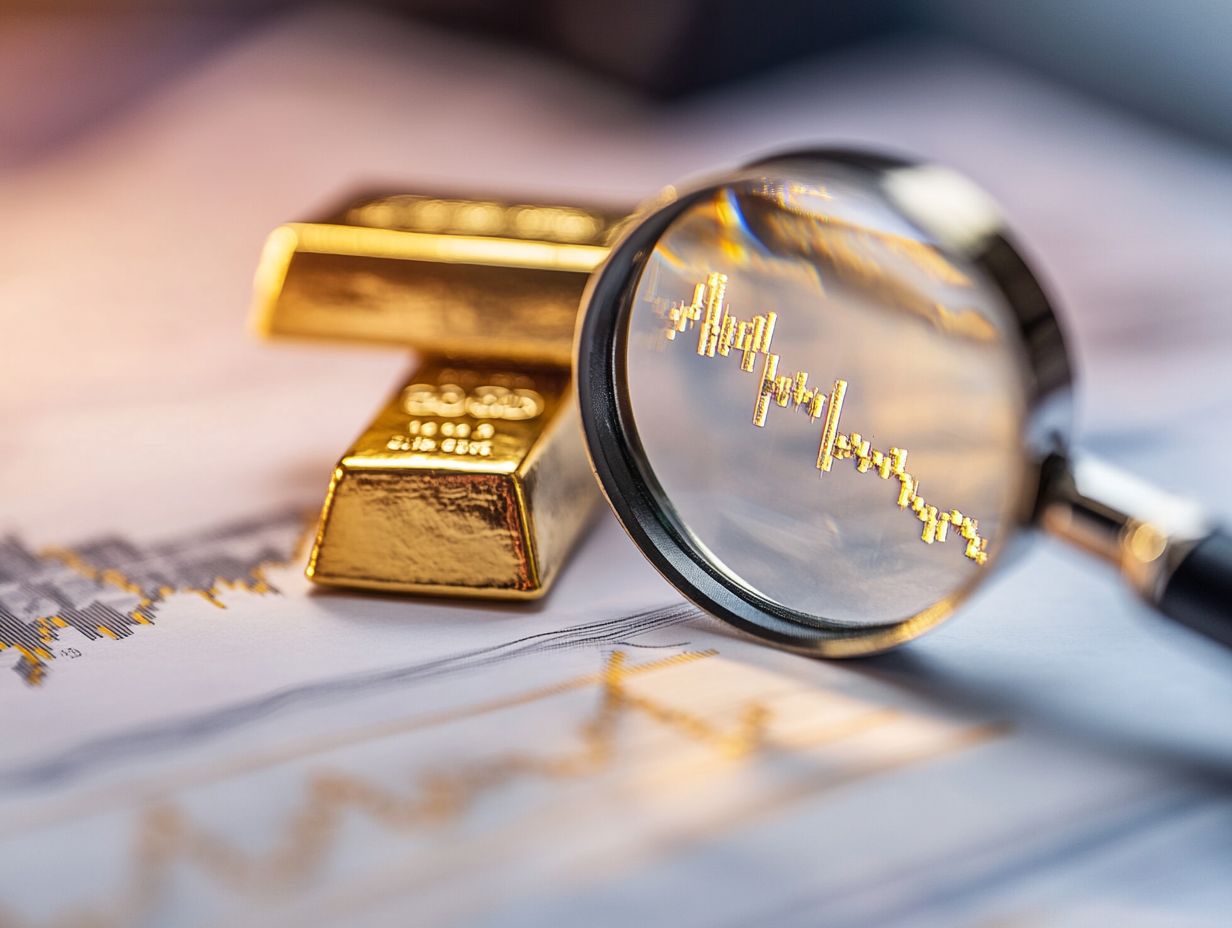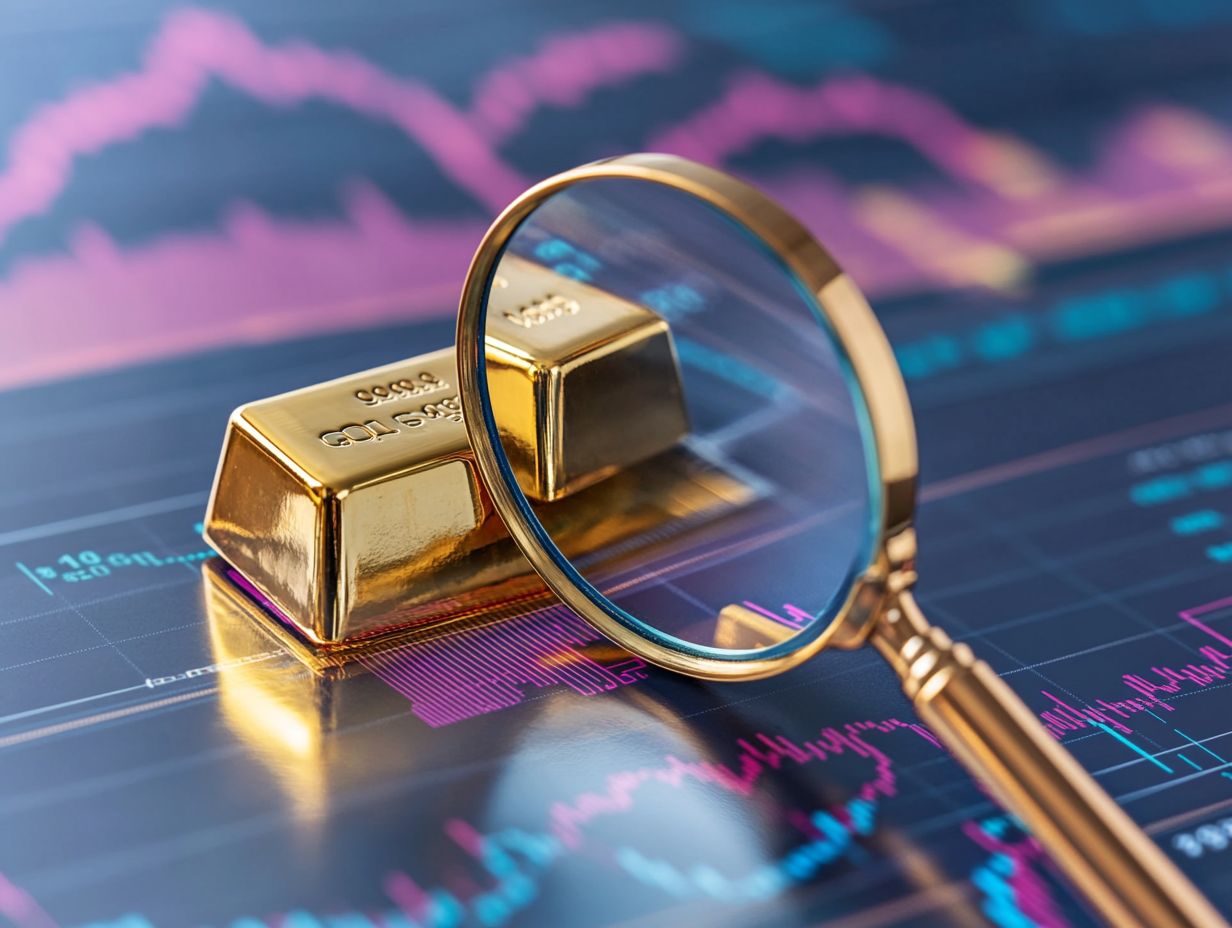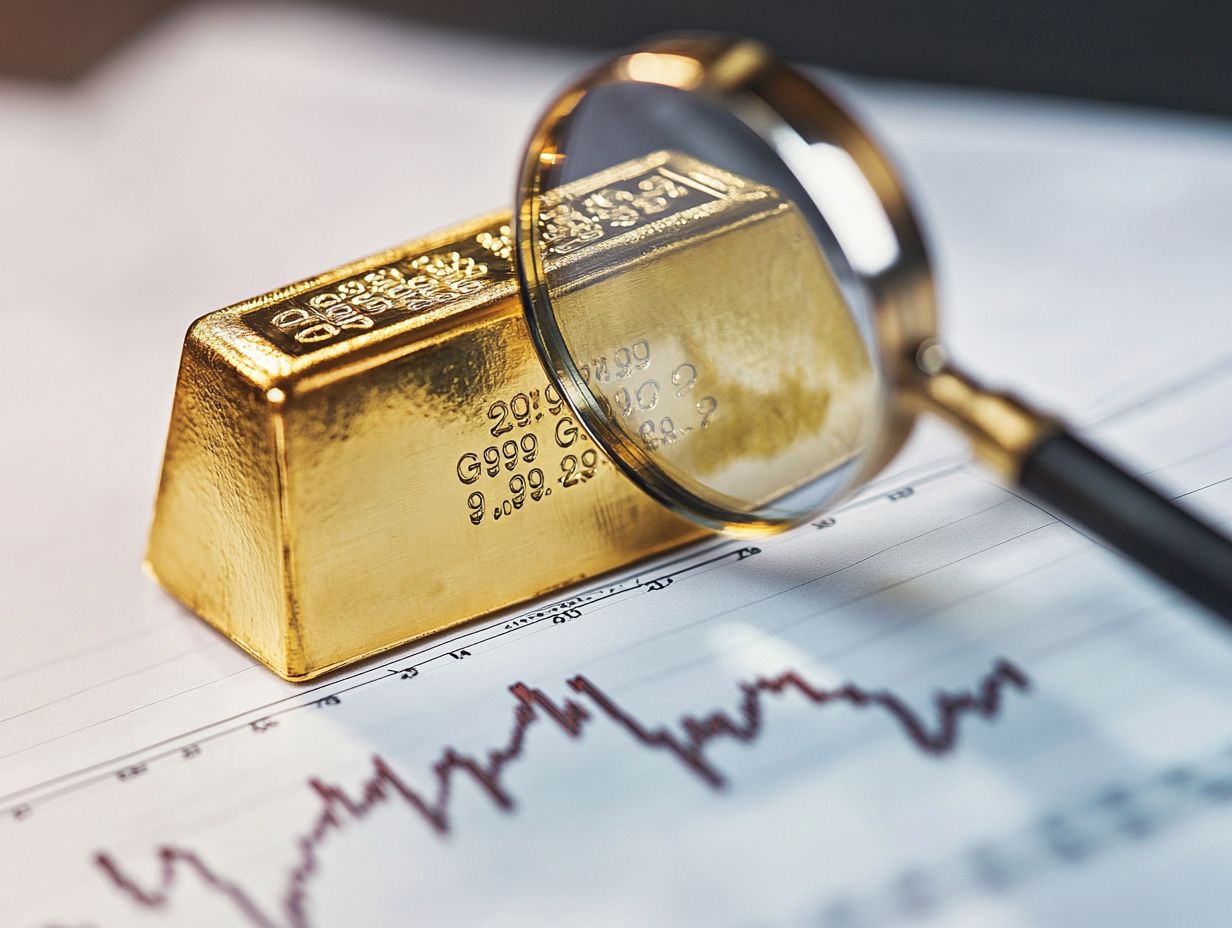How to Spot Price Manipulation in Gold Markets?
Gold markets, often seen as a refuge for investors, can sometimes become targets of price manipulation.
Understanding this issue is essential for anyone involved in gold trading or investing. This article discusses the nature of price manipulation, why gold is particularly vulnerable, and how to spot its signs.
It also examines the root causes of these manipulations and provides practical strategies to protect your investments.
By staying informed, you empower yourself to navigate the complexities of the gold market confidently.
Contents
- Key Takeaways:
- Understanding Price Manipulation in Gold Markets
- Signs of Price Manipulation in Gold Markets
- Causes of Price Manipulation in Gold Markets
- How to Protect Yourself from Price Manipulation
- Frequently Asked Questions
- What is price manipulation in gold markets?
- How can I spot price manipulation in gold markets?
- Who is Responsible for Price Manipulation in Gold Markets?
- Why Do People Manipulate the Price of Gold?
- What Are the Consequences of Price Manipulation in Gold Markets?
- How Can I Protect Myself from Falling Victim to Price Manipulation in Gold Markets?
Key Takeaways:

- Be cautious of unusual price movements in the gold market; they may indicate manipulation.
- Watch for discrepancies between supply and demand, which can signal price manipulation.
- Stay informed about market players and regulations to protect yourself from manipulation in the gold market.
Understanding Price Manipulation in Gold Markets
Understanding price manipulation in gold markets requires exploring various financial dynamics and structures. Gold, a precious metal known for its historical significance and investment potential, often experiences price fluctuations influenced by numerous factors, including market forces and actions by key players like central banks and financial institutions.
Price manipulation undermines market integrity, creating uncertainty for investors who rely on transparent price movements for informed trading decisions. Therefore, understanding these manipulative practices is crucial for anyone looking to navigate the complex world of gold trading effectively.
What is Price Manipulation?
Price manipulation refers to the intentional distortion of market prices, often carried out through unethical tactics or deceptive practices by various market participants, including financial institutions and traders.
This phenomenon includes strategies like spoofing where traders place orders they have no intention of executing to create a false impression of market demand and wash trading, which involves simultaneously buying and selling the same asset, inflating trading volume with no real exchange of ownership.
For instance, in the gold market, a trader might use spoofing by placing a large sell order, only to cancel it shortly after. This creates a false impression of increased selling pressure, misleading other market participants. Understanding how to use gold to diversify your portfolio can help investors navigate such market tactics effectively.
Regulators are increasingly taking action against these practices, as bodies like the Commodity Futures Trading Commission (CFTC) strive to maintain market integrity. These unethical tactics not only distort pricing but also erode trust in financial markets. Therefore, enforcing strict regulations and promoting transparent trading practices is essential.
Why is Gold a Target for Manipulation?
Gold is often targeted for manipulation due to its status as a safe-haven asset during economic downturns and inflationary periods. This reputation drives up demand and adds volatility to the market.
The long-standing view of gold as a symbol of wealth and security further exacerbates this vulnerability. Fluctuations in mining output and geopolitical tensions create opportunities for traders to exploit price discrepancies. In uncertain economic times, central banks may alter their gold reserves, causing ripple effects throughout the market.
Investors often react emotionally to market signals, which can lead to herd behavior that pushes prices in one direction. Thus, it’s vital for buyers and sellers to remain well-informed about these underlying factors.
Stay alert and informed to protect your investments in the gold market!
Signs of Price Manipulation in Gold Markets
Identifying signs of price manipulation in gold markets requires recognizing several key indicators that may suggest irregularities in price action, trading volume, and overall market conditions.
Stay vigilant for unusual price movements that diverge significantly from historical trends or patterns. These deviations can often point to potential manipulation tactics employed by larger market players.
Be mindful of discrepancies in supply and demand metrics and insufficient market surveillance. These factors can indicate manipulative behaviors that undermine the market’s integrity and transparency. Additionally, understanding how to protect your gold investments is crucial for safeguarding your assets.
Unusual Price Movements

Unusual price movements in the gold market often hint at possible manipulation, particularly when they arise without clear justification or any connection to underlying market fundamentals.
Fluctuations can manifest in various ways, such as sudden spikes or sharp drops in value that significantly deviate from historical trends or economic indicators. For instance, the dramatic gold crash in 2013 raised questions about whether speculative trading had skewed valuations.
In 2016, the surge in gold prices attracted scrutiny as several large trades coincided suspiciously with geopolitical tensions, raising eyebrows among regulators.
These examples show how suspicious price shifts can lead to serious investigations, potentially resulting in legal consequences when foul play or market manipulation is suspected.
Discrepancies in Supply and Demand
Discrepancies in supply and demand for gold can serve as a critical indicator of potential price manipulation. These imbalances often lead to distorted price actions that can mislead you, the investor.
When market participants perceive an oversupply, often due to increased mining output or reduced industrial demand, prices may temporarily dip, creating opportunities for savvy traders. Conversely, geopolitical tensions or central bank acquisitions can trigger sudden surges in demand, causing gold prices to rise swiftly. For those looking to take advantage of these market fluctuations, understanding how to sell your gold investments profitably is crucial.
Take, for example, the 2008 financial crisis. Heightened fears about economic stability propelled gold to record highs, illustrating how sudden shifts in sentiment can significantly magnify price changes. This delicate interplay between market psychology and the physical supply of gold presents both risks and rewards for you in this intricate market.
Causes of Price Manipulation in Gold Markets
To grasp the causes of price manipulation in gold markets, delve into the motivations and incentives that drive market participants and the regulatory framework governing trading activities.
Various players, including financial institutions and hedge funds (investment funds aiming for high returns), may resort to manipulation for short-term gains, often swayed by market volatility and economic uncertainties. Regulatory bodies, like the Commodity Futures Trading Commission, are essential in monitoring these activities.
However, the effectiveness of market surveillance remains a critical topic of debate among investors and analysts.
Market Players and Incentives
Market players involved in gold trading, including hedge funds and institutional investors, operate with distinct incentives that can lead to price manipulation aimed at maximizing profits.
Hedge funds often wield considerable capital, using it to sway market trends and drive prices up or down based on their trading strategies. Similarly, institutional investors, in their quest to diversify portfolios, might make large-scale purchases or sales of gold futures (contracts to buy or sell gold at a future date), which can significantly impact market stability. For those interested in the how to invest in gold, these market movements are crucial to understand.
These activities can create scenarios where the gold market experiences artificial inflation or deflation, pushing smaller investors to act against their best interests. For example, a hedge fund anticipating an economic downturn may resort to short selling gold, inciting panic and triggering a negative price spiral. To avoid such pitfalls, knowing the best places to buy physical gold is essential, ultimately reaping profits from the ensuing chaos.
Understanding these dynamics is essential for grasping the complexities of gold market behavior.
Regulatory Factors
Regulatory factors play a crucial role in combating price manipulation in the gold market. Agencies like the Commodity Futures Trading Commission monitor trading activities closely to uphold market integrity.
This Commission collaborates with other regulatory bodies such as the Securities and Exchange Commission and various international organizations to establish a strong framework dedicated to investor protection. They use a variety of enforcement mechanisms, including audits and rigorous reporting requirements, to deter unethical practices.
However, challenges abound. The rapid advancement of trading technology and the complexity of types of financial products make it increasingly difficult to maintain effective oversight. Additionally, the global nature of gold trading introduces jurisdictional issues that hinder enforcement and raise concerns about market transparency.
Regulators must keep up with the fast-changing gold market to protect its integrity.
How to Protect Yourself from Price Manipulation

Protecting yourself from price manipulation in the gold market requires a smart mix of investment diversification and a keen awareness of market trends. Be proactive in understanding the current market conditions and the underlying forces that influence price fluctuations.
This understanding can enhance your decision-making skills and reduce risks tied to manipulation. By adopting diversified trading strategies and committing to continuous education, you can strengthen your position against potential market distortions.
Diversifying Your Investments
Diversifying your investments across various asset classes, such as gold and other precious metals, can significantly reduce the risks associated with price manipulation in today s volatile market.
Incorporating a mix of assets creates a robust buffer against economic uncertainty and inflation. Gold, in particular, is well-known for its stability and is frequently seen as a safe haven during turbulent times. This strategic allocation not only protects your wealth but also enhances the overall performance of your portfolio, as different assets tend to respond uniquely to market fluctuations.
As one asset class rises, another may fall, allowing you to capitalize on profit opportunities while minimizing exposure to losses. This approach ultimately contributes to long-term financial stability, setting you on a path toward greater wealth resilience.
Staying Informed and Educated
Staying informed and educated about market trends is essential for any investor looking to navigate the complexities of gold trading and shield against potential price manipulation.
Don t miss out explore various resources like financial news websites, specialized forums, and market analysis platforms. Engaging with industry experts through webinars and podcasts can provide you with invaluable insights into current trends and future forecasts.
Consider subscribing to reputable newsletters focusing on precious metals; sign up now to stay informed! You can also use tools like market simulators to practice trading strategies without any financial risk, enhancing your understanding of how gold reacts to global events and economic shifts.
Frequently Asked Questions
What is price manipulation in gold markets?
Price manipulation in gold markets refers to intentional actions taken by individuals or groups to artificially influence the price of gold for their financial benefit.
How can I spot price manipulation in gold markets?

There are several signs to look out for when trying to spot price manipulation in gold markets, including sudden and significant price changes, unexplained trading activity, and discrepancies in supply and demand indicators.
Who is Responsible for Price Manipulation in Gold Markets?
Price manipulation in gold markets can be carried out by various entities, including large banks, governments, and even individual traders. It is often difficult to identify the specific perpetrators due to the complexity of the market.
Why Do People Manipulate the Price of Gold?
The main motivation for individuals or groups to manipulate the price of gold is financial gain. By artificially influencing the price, they can create opportunities for themselves to profit from the market.
What Are the Consequences of Price Manipulation in Gold Markets?
Price manipulation in gold markets can have significant consequences on the economy, as well as on investors and consumers. It can result in market instability, unfair competition, and losses for those who are not aware of the manipulation.
How Can I Protect Myself from Falling Victim to Price Manipulation in Gold Markets?
One way to protect yourself from price manipulation in gold markets is to stay informed and educated about the market. It is also important to carefully analyze market trends and seek advice from reputable sources before making any investment decisions.













